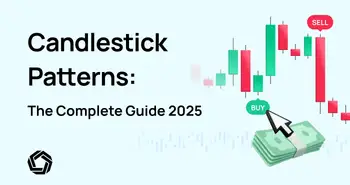A Step-by-Step Guide to Chart Pattern Analysis

Chart pattern analysis is an essential skill for any trader or investor looking to make informed decisions in the financial markets. By understanding and recognizing chart patterns, you can gain valuable insights into market trends and potential price movements. In this step-by-step guide, I will walk you through the basics of chart pattern analysis, the different types of chart patterns, how to identify them, and the process of analyzing them effectively to improve your trading strategies.
Understanding the Basics of Chart Pattern Analysis
Let's start by defining what chart pattern analysis is and why it is crucial in trading. Chart pattern analysis is the study of price movements and patterns on a chart to identify potential opportunities or trends. By analyzing historical price data, we can identify repeating patterns that often indicate future price behavior. This analysis helps traders make decisions based on probabilities, as patterns tend to repeat themselves over time.
As a trader, understanding the basics of chart pattern analysis is key to developing a successful trading strategy. It allows you to identify potential entry and exit points, manage risk effectively, and increase the probability of profitable trades.
What is Chart Pattern Analysis?
Chart pattern analysis involves studying the price movements depicted on a chart to identify patterns that can provide insights into future market behavior. These patterns can be simple or complex, but they all convey important information about supply and demand dynamics.
For example, one commonly observed chart pattern is the “head and shoulders” pattern. This pattern consists of three peaks, with the middle peak being the highest. It indicates a potential trend reversal from bullish to bearish. Traders who recognize this pattern may choose to sell their positions, anticipating a downward price movement.
Importance of Chart Pattern Analysis in Trading
Chart pattern analysis is crucial in trading because it helps traders anticipate potential price movements and make informed trading decisions. By identifying patterns, traders can determine when a market is likely to reverse, continue, or consolidate its current trend.
Furthermore, chart patterns also provide valuable information about potential support and resistance levels, which are essential for setting stop-loss orders and determining profit targets. Support levels are price levels at which buying pressure is expected to outweigh selling pressure, causing prices to bounce back up. Resistance levels, on the other hand, are price levels at which selling pressure is expected to outweigh buying pressure, causing prices to reverse or consolidate.
By combining chart pattern analysis with other technical analysis tools, such as trend lines and indicators, traders can enhance their trading strategies and improve their odds of success. For instance, a trader may use moving averages in conjunction with chart patterns to confirm potential trend reversals or breakouts.
Types of Chart Patterns
When analyzing stock charts, traders often look for patterns that can help predict future price movements. There are two main types of chart patterns: reversal patterns and continuation patterns. Each type provides valuable insights into market trends and potential trading opportunities.
Reversal Patterns
Reversal patterns are crucial for identifying potential trend reversals in the market. These patterns typically form at the end of a trend and can signal a shift in market sentiment. Traders use reversal patterns to anticipate when a current trend may be losing strength or coming to an end. Some common reversal patterns include the head and shoulders pattern, double tops, and double bottoms. Recognizing these patterns early can help traders make informed decisions about when to enter or exit trades.
Continuation Patterns
Continuation patterns, on the other hand, provide insight into the temporary pauses or consolidation periods within an existing trend. These patterns suggest that after a brief period of rest or sideways movement, the current trend is likely to continue. Traders use continuation patterns such as triangles, flags, and pennants to confirm the direction of the trend and look for potential entry points to ride the trend further. Understanding these patterns can help traders stay in winning trades longer and maximize their profits.
How to Identify Chart Patterns
Identifying chart patterns is an essential skill for any trader looking to capitalize on market trends. Here are a few key methods for identifying chart patterns:
Spotting Trend Lines
Trend lines are one of the most basic and powerful tools for identifying chart patterns. By drawing trend lines connecting swing highs or swing lows, you can easily spot patterns such as ascending triangles, descending triangles, or symmetrical triangles.
Furthermore, trend lines can also help traders identify channels, which are parallel trend lines that contain price action. Channels can be ascending, descending, or horizontal, providing valuable insights into potential breakout or breakdown points.
Recognizing Support and Resistance Levels
Support and resistance levels play a crucial role in identifying chart patterns. By observing areas where the price has historically found support or faced resistance, you can identify patterns like double tops or double bottoms.
In addition to double tops and double bottoms, support and resistance levels can also help traders identify head and shoulders patterns. These patterns consist of a peak (head) surrounded by two lower peaks (shoulders), indicating a potential trend reversal.
The Process of Analyzing Chart Patterns
Now that you understand the basics of chart pattern analysis and how to identify patterns let's dive into the process of analyzing chart patterns effectively. Here's a step-by-step guide:
Step 1: Selecting the Right Chart
Start by selecting the appropriate time frame for your analysis. The time frame you choose will depend on your trading style and preferences. Short-term traders may focus on hourly or daily charts, while long-term investors may analyze weekly or monthly charts.
Step 2: Identifying the Pattern
Once you have selected your chart, scan it for potential chart patterns. Look for recognizable patterns that fit the criteria for reversal or continuation patterns, based on their characteristics and price behavior.
Step 3: Analyzing the Pattern
Analyzing the pattern involves assessing the strength and reliability of the pattern. Consider factors such as volume, duration, and the overall market context. Confirm the pattern with additional technical indicators, such as moving averages or oscillators, to increase the probability of a successful trade.
Common Mistakes in Chart Pattern Analysis
Even the most experienced traders can make mistakes in chart pattern analysis. Here are two common mistakes to avoid:
Overlooking the Market Context
One common mistake is to overlook the broader market context when analyzing chart patterns. It's essential to consider the overall market trend, news events, and other external factors that may influence price movements. Ignoring these factors can lead to false signals and poor trading decisions.
Misinterpreting the Patterns
Another mistake is misinterpreting chart patterns. It's crucial to understand the characteristics and behavior of each pattern to avoid false signals. Take the time to study and familiarize yourself with different chart patterns before making trading decisions solely based on them.
As an expert in chart pattern analysis, I've personally witnessed the power of this approach in my trading career. One piece of advice I can give you is to combine chart pattern analysis with other technical analysis tools, such as indicators or candlestick patterns. The more confluence of signals you have, the higher the probability of a successful trade.
FAQ
What is chart pattern analysis?
Chart pattern analysis is the study of price movements and patterns on a chart to identify potential market trends and price movements.
Why is chart pattern analysis important in trading?
Chart pattern analysis helps traders make informed trading decisions by identifying potential entry and exit points, managing risk, and improving the probability of profitable trades.
What are the types of chart patterns?
The two main types of chart patterns are reversal patterns, which indicate a potential trend change, and continuation patterns, which suggest the current trend will continue after a period of consolidation.
How do I identify chart patterns?
You can identify chart patterns by spotting trend lines, recognizing support and resistance levels, and analyzing the behavior of price movements.
What are common mistakes in chart pattern analysis?
Common mistakes in chart pattern analysis include overlooking the market context and misinterpreting the patterns. By considering the broader market trends and understanding the characteristics of each pattern, you can avoid these pitfalls.
Now that you have a step-by-step guide to chart pattern analysis, make sure to practice and apply this valuable skill in your trading journey. Remember, combining knowledge with experience is the key to success in the financial markets.
Ready to put your chart pattern analysis skills into action? Join Morpher, the revolutionary trading platform that's changing the game with blockchain technology. With Morpher, you can trade a vast array of assets, from stocks and crypto to unique markets, all with zero fees and infinite liquidity. Start investing with as little as $1, take advantage of 10x leverage, and enjoy the safety of a non-custodial wallet. Experience the future of trading with Virtual Futures on the Ethereum Blockchain. Sign Up and Get Your Free Sign Up Bonus today, and elevate your trading strategy with Morpher.

Disclaimer: All investments involve risk, and the past performance of a security, industry, sector, market, financial product, trading strategy, or individual’s trading does not guarantee future results or returns. Investors are fully responsible for any investment decisions they make. Such decisions should be based solely on an evaluation of their financial circumstances, investment objectives, risk tolerance, and liquidity needs. This post does not constitute investment advice.

Painless trading for everyone
Hundreds of markets all in one place - Apple, Bitcoin, Gold, Watches, NFTs, Sneakers and so much more.

Painless trading for everyone
Hundreds of markets all in one place - Apple, Bitcoin, Gold, Watches, NFTs, Sneakers and so much more.









